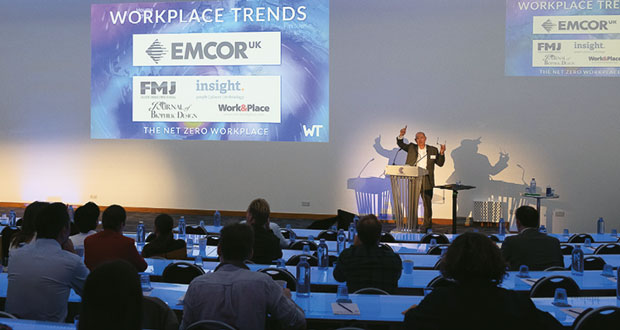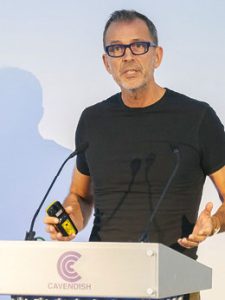The Net Zero Workplace conference offered some realistic actions that can be taken in the design and management of workspaces that meet net zero targets
We’re on the cusp of the greatest change in human history said Jeremy Campbell, Executive Director, EMCOR UK, introducing The Net Zero Workplace, organised by the Workplace Trends team which took place in person and online in July. “As a community of workplace people, we can make a massive difference to the urgent imperative to address climate change. It’s not good enough to do nothing, we’ve got to make a difference and that begins now.”
Campaigner Georgia Elliott-Smith of Element Four set out the challenge in stark terms. We’re at a point of climate and ecological crisis and it is time to adopt a new approach that delivers meaningful impact. She advocates “disruptive sustainability,” a combination of best practice and activism that generates purpose and drives actions necessary to achieve meaningful change in industry. To that end she has joined the extinction rebellion protests as well as challenging the UK government in the High Court over the proposed UK Emissions Trading Scheme and its failure to uphold the Paris Agreement. “We’ve got to step away from saying our company is net zero”, she said. “It may look great in the brochure but what have you done that is delivering meaningful change?”
Environmental Psychologist Anicee Bauer echoed Elliott-Smith’s sentiments in her talk on ‘designing sustainable habitats for sustainable habits’. The problem with greenwashing, she said, “is when companies feel obliged to put clean, green energy and sustainability in their mission statements, but they’re actually just living a quiet life on paper. There needs to be a commitment to integrity within organisations by matching up what they preach to the outside with what is actually happening within the organisation”.
GAMIFICATION OF NET ZERO
Taking a competitive approach to the issue, CUBE is the UK’s first competition to tackle the dual challenges of occupier engagement and energy efficiency improvement in commercial buildings by getting landlords, building managers and occupiers to compete with other buildings to reduce energy consumption. Introducing the concept, Mark Bruno of Ampersand Partners and Andy Mazzucchelli of Landsec revealed that a new BREEAM building had cut emissions by nearly 50 per cent by taking part, as previously despite the design it “wasn’t being used the way it should have been used due to behaviour issues”.
Driving home the message that how we manage spaces impacts their sustainability, was workplace expert Neil Usher from GoSpace AI. He explained we can no longer match supply and demand by having planners in the back room, instead, applying AI-driven dynamic scheduling technology allows occupants to choose where they sit in the workplace while enabling workplace managers to consolidate the amount of space used to help save energy. This tech helps to resolve the problem of managing hybrid working patterns, by maximising the opportunity for organisations to meet net zero, on a floor by floor, building by building basis.
SUSTAINABLE WELLBEING
Ian Baker, Head of Workplace, EMCOR UK remarked in his introduction to the afternoon sessions that we’re becoming far more aware of the link between sustainability and wellbeing. He maintained that in order to reduce the consumption of energy in buildings we first need to measure it as otherwise, the assets we look after and don’t measure are leaky buckets.
The session on reducing Embodied Carbon in the Workplace by Adam Strudwick of Perkins & Will was a useful primer. In just one example we heard how adaptable prefabricated meeting rooms that are growing in favour to support hybrid work patterns, are more sustainable as they can be disconnected and reused. He also advised setting carbon budgets in the same ways as project teams set cost budgets.
With the office now having to compete with the home, you not only need to encourage people to want to commute to the workplace but provide end of route facilities that help them choose active travel. Neil Webster of Remit Consulting explained the thinking behind the BCO Report: The Impact of Active Travel on Real Estate and the Workplace.
Rounding off the day was a case study by Henry Pelly, Max Fordham LLP and Mike McMahon, Eric Parry Architects on the development of 11 Belgrave Road, a net zero workplace in London Victoria, which sets new standards in design, sustainability and wellbeing. Along with its energy management accolades; being the UK’s first building to achieve a 5.5 Star NABERS UK design-reviewed target rating for efficiency, zero carbon in both construction and operation, and having a design stage BREEAM Outstanding rating, it is also one of only six UK buildings to pre-certify for WELL Platinum. The Wellness elements of the building, including generous end of route facilities reflects the growing understanding that working to achieve net zero brings benefits to the environment and building occupants.
The day had a strong positive message and one which cut through much of the greenwash which can permeate the net zero challenge. As Elliott-Smith said, we can all be activists in our own way by being the grown-ups in the room, telling the truth and making sure we make a real difference.






